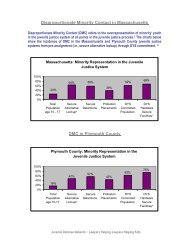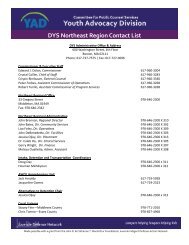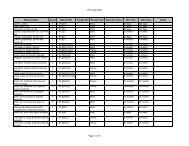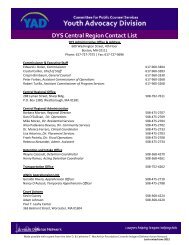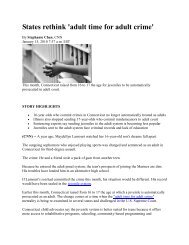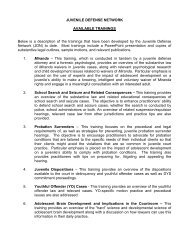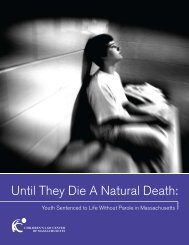Adolescent Brain Development - the Youth Advocacy Division
Adolescent Brain Development - the Youth Advocacy Division
Adolescent Brain Development - the Youth Advocacy Division
Create successful ePaper yourself
Turn your PDF publications into a flip-book with our unique Google optimized e-Paper software.
Scientific Backing<br />
• Myelination is <strong>the</strong> main index by which brain maturity is measured. Myelin implies more mature, efficient<br />
connections, within <strong>the</strong> brain’s ‘gray matter.’ UCLA researchers performed a study comparing myelination of<br />
young adults aged 23-30 with adolescents aged 12-16. They found that <strong>the</strong>re was a stark contrast in <strong>the</strong><br />
myelination, especially in <strong>the</strong> frontal lobe and frontal cortex, <strong>the</strong> areas that relate to <strong>the</strong> maturation of cognitive<br />
processing and o<strong>the</strong>r ‘executive functions.’ 7<br />
• According to studies using advances in MRI technology, <strong>the</strong> area of <strong>the</strong> brain (frontal lobe) that is most related to<br />
decision making, planning, risk-assessment, judgment, and o<strong>the</strong>r factors generally associated with criminal<br />
culpability is also one of <strong>the</strong> last to fully mature. 8<br />
• According to research conducted by Lawrence Steinberg, a noted Professor of Psychology at Temple University,<br />
“risky behavior in adolescence is <strong>the</strong> product of <strong>the</strong> interaction between changes in two distinct neurobiological<br />
systems: a socioemotional system [which includes <strong>the</strong> amygdala and medial prefrontal cortex]. . . and a cognitive<br />
control system.” 9 Steinberg has noted that “changes in <strong>the</strong> socioemotional system at puberty may promote<br />
reckless, sensation-seeking behavior in early and middle adolescence, while <strong>the</strong> regions of <strong>the</strong> prefrontal cortex<br />
that govern cognitive control continue to mature over <strong>the</strong> course of adolescence and into young adulthood. This<br />
temporal gap between <strong>the</strong> increase in sensation seeking around puberty and <strong>the</strong> later development of mature selfregulatory<br />
competence may combine to make adolescence a time of inherently immature judgment. Thus, despite<br />
<strong>the</strong> fact that in many ways adolescents may appear to be as intelligent as adults (at least as indexed by<br />
performance on tests of information processing and logical reasoning), <strong>the</strong>ir ability to regulate <strong>the</strong>ir behavior in<br />
accord with <strong>the</strong>se advanced intellectual abilities is more limited.” 10<br />
• According to a study at Harvard’s McLean Hospital, young teens tend to rely more on <strong>the</strong> part of <strong>the</strong> brain<br />
(amygdala) responsible for fear and o<strong>the</strong>r ‘gut reactions’ when responding to o<strong>the</strong>r people’s emotions. Adults in<br />
contrast, more often utilize <strong>the</strong> frontal lobe, <strong>the</strong> part of <strong>the</strong> brain which yields more reasoned perceptions. 11<br />
• According to a study performed by researches using MRI technology at <strong>the</strong> National Institute on Alcohol Abuse<br />
and Alcoholism, adolescents use lower activation of <strong>the</strong> part of <strong>the</strong> brain that is “crucial for motivating behavior<br />
toward <strong>the</strong> prospect of rewards.” The study concludes that youth differ significantly in <strong>the</strong>ir responses to “rewarddirected<br />
behavior.” 12<br />
• The production of testosterone, a hormone that is closely associated with aggression, increases approximately<br />
tenfold in adolescent boys. 13<br />
1<br />
American Bar Association (ABA): Juvenile Justice Center. Adolescence, <strong>Brain</strong> <strong>Development</strong> and Legal Culpability. 2004.<br />
2<br />
Fagan, Jeffrey. “<strong>Adolescent</strong>s, Maturity, and <strong>the</strong> Law. The American Prospect. August, 2005.<br />
3<br />
Graham v. Florida, No. 08-7412, slip. op. at 17, 560 U.S. __ (2010) (quoted from Roper v. Simmons 543 U.S. at 569-570 (2005)).<br />
4<br />
Gur, Ruben C., Ph.D. Declaration of Ruben C. Gur. Patterson v. Texas. Petition for Writ of Certiorari to US Supreme Court, J. Gary<br />
Hart, Counsel. (2002).<br />
5<br />
Gur, op. cit.<br />
6<br />
Gur, op. cit.<br />
7<br />
National Institute of Mental Health (NIMH). Teenage <strong>Brain</strong>: A Work in Progress. A brief overview of research into brain<br />
development during adolescence. 2001. See also: Sowell, Elizabeth, et al. In vivo evidence for post-adolescent brain maturation in<br />
frontal and striatal regions. Nature Neuroscience, 1999; 2(10): 859-861.<br />
8<br />
Fagan, op, cit. See also: Goldberg, Elkhonon. The Executive <strong>Brain</strong>, Frontal Lobes and <strong>the</strong> Civilized Mind, (2001).<br />
9<br />
Lawrence Steinberg, <strong>Adolescent</strong> <strong>Development</strong> and Juvenile Justice, ANNU. REV. CLIN. PSYCHOL. 2009. 5:47–73 at 54.<br />
10<br />
Id. at 55.<br />
11<br />
NIMH, op cit. See also: Baird, et al. Functional magnetic resonance imaging of facial affect recognition in children and adolescents.<br />
Journal of <strong>the</strong> American Academy of Child and <strong>Adolescent</strong> Psychiatry, 1999; 38(2): 195-9.<br />
12<br />
National Institute on Alcohol Abuse and Alcoholism (NIAAA). <strong>Adolescent</strong> <strong>Brain</strong>s Show Reduced Reward Anticipation, 2004.<br />
13<br />
See Adams, Gerald R., Montemayor, Raymond, and Gullota, Thomas P., eds. Psychosocial <strong>Development</strong> during Adolescence. Sage<br />
Publications: Thousand Oaks, CA. (1996).





